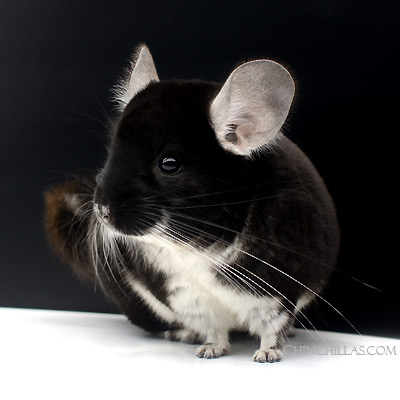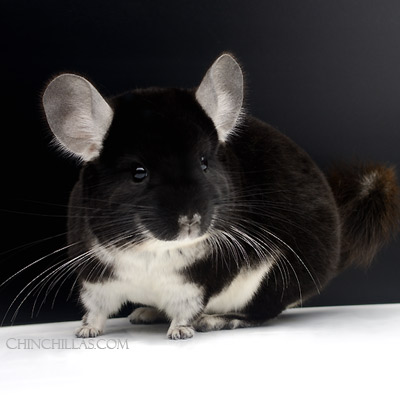Black Pearl Chinchillas

Viable new color mutation chinchillas do not appear frequently. The most recent is the Black Pearl which appeared in the herd of Thomas and Elzbieta Kucharczak of Poland.
 The Kucharczaks started breeding chinchillas in 1994. After breeding chinchillas for 13 years their Standard herd had grown to a good size. Unexpectedly, their Standards produced an unusual male kit one day in 2007. That kit would be the first homozygote for a new mutation, which Thomas and Elzbieta subsequently named the Black Pearl. Based on information that a second Black Pearl male was born out of their Standard breeding stock the following year, it would have been the Kucharczak’s two Standard heterozygote parents that were the original known mutant chinchillas - the F1s.
The Kucharczaks started breeding chinchillas in 1994. After breeding chinchillas for 13 years their Standard herd had grown to a good size. Unexpectedly, their Standards produced an unusual male kit one day in 2007. That kit would be the first homozygote for a new mutation, which Thomas and Elzbieta subsequently named the Black Pearl. Based on information that a second Black Pearl male was born out of their Standard breeding stock the following year, it would have been the Kucharczak’s two Standard heterozygote parents that were the original known mutant chinchillas - the F1s.
In 2008, the Kucharczak’s established the first Black Pearl breeding run - consisting of their 2007 Black Pearl male and four standard females. In 2009 they established another run of Black Pearls using their second Black Pearl male and four Standard females. After enough kits had been born over successive generations, the pattern of inheritance indicated that they had a simple two-allele recessive.
 In 2014 the Kucharczaks started showing their new mutation, in Hungary, where one of the new Black Pearls was awarded a championship ribbon. By late January of 2015, at their next show in Belgian, a class had been added for the new Black Pearl mutation.
In 2014 the Kucharczaks started showing their new mutation, in Hungary, where one of the new Black Pearls was awarded a championship ribbon. By late January of 2015, at their next show in Belgian, a class had been added for the new Black Pearl mutation.
The Black Pearl mutation has a distinct look. The fur on the top and sides has a black tip, with a dark charcoal grey bar and dark charcoal grey underfur. The belly fur has a white tip with charcoal grey underfur. There is a very slight color distinction to the tip of the fur at the sides near the white belly, and the top of the animal; morphing from charcoal grey to black. The tail fur is white at the base, changing to predominantly black, with a brown / fading-black coloration at the tip. Upon first glance, the Black Pearl has a very distinct ‘black & white’ appearance. It is not until one looks closer that the subtle color nuances become apparent. The Black Pearl chinchillas are attractive, generally docile and kind, and have had a positive contribution - now globally - to chinchilla breeding. The early success of this recessive, never an easy task, is attributable to the careful selective breeding by the Kucharczaks of Poland.
Only a handful of Black Pearl hybrids have been produced so far, including the Beige Pearl (heterozygous Tower Beige & homozygous Black Pearl), but it is likely just a matter of time before more variations appear.
Visit the Chinchillas.com Auction database to view additional pictures of Black Pearl chinchillas, or see new chinchillas for sale in the Sales Gallery.